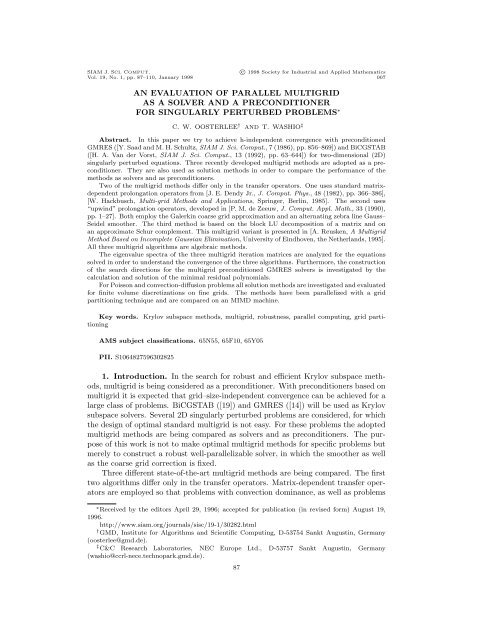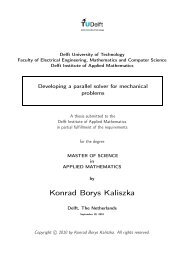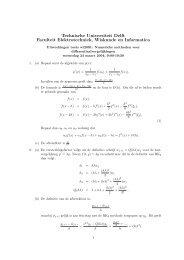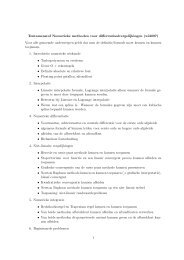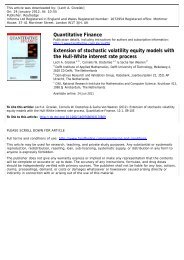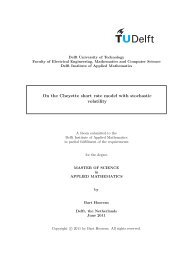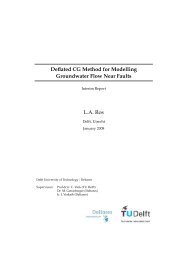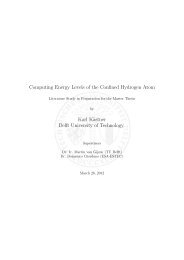AN EVALUATION OF PARALLEL MULTIGRID AS A SOLVER AND A ...
AN EVALUATION OF PARALLEL MULTIGRID AS A SOLVER AND A ...
AN EVALUATION OF PARALLEL MULTIGRID AS A SOLVER AND A ...
You also want an ePaper? Increase the reach of your titles
YUMPU automatically turns print PDFs into web optimized ePapers that Google loves.
SIAM J. SCI. COMPUT.c○ 1998 Society for Industrial and Applied MathematicsVol. 19, No. 1, pp. 87–110, January 1998 007<strong>AN</strong> <strong>EVALUATION</strong> <strong>OF</strong> <strong>PARALLEL</strong> <strong>MULTIGRID</strong><strong>AS</strong> A <strong>SOLVER</strong> <strong>AN</strong>D A PRECONDITIONERFOR SINGULARLY PERTURBED PROBLEMS ∗C. W. OOSTERLEE † <strong>AN</strong>D T. W<strong>AS</strong>HIO ‡Abstract. In this paper we try to achieve h-independent convergence with preconditionedGMRES ([Y. Saad and M. H. Schultz, SIAM J. Sci. Comput., 7 (1986), pp. 856–869]) and BiCGSTAB([H. A. Van der Vorst, SIAM J. Sci. Comput., 13 (1992), pp. 63–644]) for two-dimensional (2D)singularly perturbed equations. Three recently developed multigrid methods are adopted as a preconditioner.They are also used as solution methods in order to compare the performance of themethods as solvers and as preconditioners.Two of the multigrid methods differ only in the transfer operators. One uses standard matrixdependentprolongation operators from [J. E. Dendy Jr., J. Comput. Phys., 48 (1982), pp. 366–386],[W. Hackbusch, Multi-grid Methods and Applications, Springer, Berlin, 1985]. The second uses“upwind” prolongation operators, developed in [P. M. de Zeeuw, J. Comput. Appl. Math., 33 (1990),pp. 1–27]. Both employ the Galerkin coarse grid approximation and an alternating zebra line Gauss–Seidel smoother. The third method is based on the block LU decomposition of a matrix and onan approximate Schur complement. This multigrid variant is presented in [A. Reusken, A MultigridMethod Based on Incomplete Gaussian Elimination, University of Eindhoven, the Netherlands, 1995].All three multigrid algorithms are algebraic methods.The eigenvalue spectra of the three multigrid iteration matrices are analyzed for the equationssolved in order to understand the convergence of the three algorithms. Furthermore, the constructionof the search directions for the multigrid preconditioned GMRES solvers is investigated by thecalculation and solution of the minimal residual polynomials.For Poisson and convection-diffusion problems all solution methods are investigated and evaluatedfor finite volume discretizations on fine grids. The methods have been parallelized with a gridpartitioning technique and are compared on an MIMD machine.Krylov subspace methods, multigrid, robustness, parallel computing, grid parti-Key words.tioningAMS subject classifications. 65N55, 65F10, 65Y05PII. S10648275963028251. Introduction. In the search for robust and efficient Krylov subspace methods,multigrid is being considered as a preconditioner. With preconditioners based onmultigrid it is expected that grid–size-independent convergence can be achieved for alarge class of problems. BiCGSTAB ([19]) and GMRES ([14]) will be used as Krylovsubspace solvers. Several 2D singularly perturbed problems are considered, for whichthe design of optimal standard multigrid is not easy. For these problems the adoptedmultigrid methods are being compared as solvers and as preconditioners. The purposeof this work is not to make optimal multigrid methods for specific problems butmerely to construct a robust well-parallelizable solver, in which the smoother as wellas the coarse grid correction is fixed.Three different state-of-the-art multigrid methods are being compared. The firsttwo algorithms differ only in the transfer operators. Matrix-dependent transfer operatorsare employed so that problems with convection dominance, as well as problems∗ Received by the editors April 29, 1996; accepted for publication (in revised form) August 19,1996.http://www.siam.org/journals/sisc/19-1/30282.html† GMD, Institute for Algorithms and Scientific Computing, D-53754 Sankt Augustin, Germany(oosterlee@gmd.de).‡ C&C Research Laboratories, NEC Europe Ltd., D-53757 Sankt Augustin, Germany(washio@ccrl-nece.technopark.gmd.de).87
88 C. W. OOSTERLEE <strong>AN</strong>D T. W<strong>AS</strong>HIOwith jumping coefficients, can be solved efficiently. The first algorithm includes wellknownmatrix-dependent operators from the literature ([3], [6]). In [3] the operatorshave been designed so that problems on grids with arbitrary mesh sizes, not just powersof two (+1), can be solved with similar efficiency. Although in [3] these operatorsare mainly used for symmetric interface problems, we will also consider them here forunsymmetric problems.The second algorithm uses the prolongation operators introduced by de Zeeuw([25]), which are specially designed for solving unsymmetric problems. Both algorithmsemploy Galerkin coarsening ([6], [24]) for building the matrices on coarsergrids. A robust smoother is a necessary requirement in standard multigrid for achievinggrid–size-independent convergence for many problems. The alternating zebra lineGauss–Seidel relaxation method was found to be a robust smoother for 2D modelequations ([15], [24]). This smoother is used since it is possible to parallelize a linesolver efficiently on a parallel machine ([23]). Constructing robust parallel solvers isan important purpose of our work.The third multigrid algorithm in our comparison is based on the block Gaussianelimination of a matrix and an approximate Schur complement. This method has beenrecently introduced by Reusken ([12]). An interesting aspect is that the M-matrix([20]) properties of a fine grid matrix are preserved on coarse grid levels. The threemultigrid methods are described in section 2.Another robust multigrid variant for solving scalar partial differential equations isalgebraic multigrid (AMG) by Ruge and Stüben ([13]), in which the smoother is fixedbut the transfer operators depend on the connections in a matrix. Efficient parallelizationof AMG is, however, not trivial. Other multigrid preconditioners have been usedfor problems on structured grids, for example, in [1], [16], [17], and for unstructuredgrids in [2]. In [9] an early comparison of multigrid and multigrid preconditioned CGfor symmetric model equations showed the promising robustness of the latter method.A comparison between multigrid as a solver and as a preconditioner for incompressibleNavier–Stokes equations is presented in [26].The solution methods are analyzed in order to understand the convergence behaviorof the MG methods used as solvers and as preconditioners. The eigenvaluespectrum of the multigrid iteration matrices for the singularly perturbed problemsis calculated in section 3. Interesting subjects for the convergence behavior are thespectral radius and the eigenvalue distribution. Another paper in which eigenvalues ofmultigrid preconditioned Krylov methods are determined for convergence analysis is[16]. Furthermore, the polynomials that give a representation of the GMRES residualin terms of the preconditioned matrix and the initial residual are explicitly computedand solved. The evolution of the subspace in which GMRES minimizes the residualcan be determined from the solution of these polynomials.Numerical results are also presented in section 3. The benefits of the constructedmultigrid preconditioned Krylov methods are shown for 2D Poisson and convectiondiffusionproblems on fine grids solved on the NEC Cenju–3 MIMD machine ([8]).The message passing is done with the message-passing interface (MPI). Furthermore,the methods are compared with MILU ([18]) preconditioned Krylov methods.In [23] we compared several standard and nonstandard multilevel preconditionersfor BiCGSTAB. The changes in the multigrid algorithm presented in this papercan also be applied to the nonstandard multilevel approach MG-S from [23]. Furtherresearch on parallel nonstandard multilevel preconditioners particularly for 3D problems(in order to avoid alternating plane smoothers) will be described in part II ofthis paper.
<strong>MULTIGRID</strong> <strong>AS</strong> A <strong>SOLVER</strong> <strong>AN</strong>D A PRECONDITIONER 8978945 612 3FIG. 1. The nine-point stencil with numbering.2. The multigrid preconditioned Krylov methods. We concentrate on linearmatrix systems with nine diagonals(1)or(2)Aφ = ba 1 i,jφ i−1,j−1 + a 2 i,jφ i,j−1 + a 3 i,jφ i+1,j−1 + a 4 i,jφ i−1,j + a 5 i,jφ i,j + a 6 i,jφ i+1,j+ a 7 i,jφ i−1,j+1 + a 8 i,jφ i,j+1 + a 9 i,jφ i+1,j+1 = b i,j ∀(i, j) ∈ G.Here, G is a subset of P nx,ny = {(i, j)|1 ≤ i ≤ n x , 1 ≤ j ≤ n y }.The stencil is presented in Figure 1 for convenience.Matrix A has right preconditioning as follows:(3)AK −1 (Kφ) = b.The Krylov subspace methods that are used for solving (3) are BiCGSTAB ([19]), asdescribed in detail in [23], and GMRES(m) ([14]).2.1. GMRES. The GMRES(m) algorithm with a right preconditioner appearsas follows:GMRES (m,A, b, φ) {Choose φ (0) , dimension m, matrix ˜H = 0 with dim: (m + 1) × mr (0) = b − Aφ (0) ; β = ||r (0) || 2 ; f 1 = r (0) /β;for j = 1, . . . , m {u j := K −1 f j ;w := Au j ;for i = 1, . . . , j {h i,j := (w, f i );w := w − h i,j f j ;h j+1,j := ||w|| 2 , f j+1 = w/h j+1,j ;}}Define F m := [f 1 , . . . , f m ];φ (m) := φ (0) + K −1 F m y m ; with y m = min y ||βe 1 − ˜Hy|| 2 ,(e 1 = [1, 0, . . . , 0] T );Compute r (m) = b − Aφ (m) ;If satisfied stop, else restart φ (0) ← φ (m) ;}K −1 f j is the preconditioning step, which is one iteration of a multigrid cycle.
90 C. W. OOSTERLEE <strong>AN</strong>D T. W<strong>AS</strong>HIOThe algorithms are described in a C-type metalanguage. The software is implementedas a combination of Fortran 77 and C. C is used for the driver routines ofthe preconditioner in order to exploit the recursiveness of C and so to simplify themultigrid implementation.Storage. The parameter m represents the number of vectors stored after whichthe GMRES(m) algorithm will restart. It is set to 20 in our work. Restart vectorsare not necessary in BiCGSTAB, where six intermediate vectors have to be stored.The work for one GMRES iteration consists of one matrix–vector product and onepreconditioning step. In BiCGSTAB two matrix–vector products and two preconditioningsteps are necessary in each iteration. The computation of one iteration ofBiCGSTAB is twice as expensive as an iteration of GMRES(m), when, as in our case,the computation is dominated by the preconditioning and the matrix–vector product.When the number of iterations needed for convergence is much larger than the restartparameter m, it might be better to choose BiCGSTAB.Parallelism is straightforward in Krylov methods, except for the multigrid preconditioner,the matrix–vector, and inner products, which need communication amongneighboring processors.Using a preconditioner as solver. A preconditioner, like the multigrid preconditioner,can easily be used as a solver. An iteration of a multigrid solver is equivalentto a Richardson iteration on the preconditioned matrix. With K being the iterationmatrix, multigrid can be written as follows:(4)Kφ (k+1) + (A − K)φ (k) = b.This formulation is equivalent to(5)φ (k+1) = φ (k) + K −1 (b − Aφ (k) ) = φ (k) + K −1 r (k) ; r (k+1) = (I − AK −1 )r (k) .The multigrid solver is implemented as a Richardson iteration with a left multigridpreconditioner for A. The convergence of (5) can be investigated by analyzing thespectrum of the iteration matrix. The spectral radius of I −AK −1 determines the convergence.This spectrum is analyzed in section 3 for the different multigrid methodsfor the problems tested on 33 2 and 65 2 grids. With this spectrum we can also investigatethe convergence of GMRES, since the spectra of left and right preconditionedmatrices are the same.Nested iteration ([6]), or full multigrid (FMG), which often reduces the numberof multigrid iterations, is closely related to the multigrid algorithms considered here.Our starting point is the sparse matrix on the finest grid, but an F-cycle withoutpresmoothing is always used.The convergence of GMRES. Here, we give an estimation of the convergence ofGMRES(m) in cases where most of the eigenvalues (the last n − l eigenvalues in thetheorem below) of the preconditioned matrix à are close to 1 ∈ C.THEOREM 2.1. Let à be an n × n nonsingular matrix with eigenvalues {λ i ∈C | 1 ≤ i ≤ n}, and let ¯V l be the subspace spanned by the vectors {v ∈ V | ∏ nk>l (λ kI −Ã)v = 0}, let K l be the Krylov subspace K(l, r (0) , Ã) = span[r(0) , Ãr(0) , . . . , Ãl−1 r (0) ],and let P k be a set of kth-order complex polynomials p k (λ) that satisfy p k (0) = 1, andr (0) = b − Ãφ(0) the initial residual. Let radius Γ i be defined as(6)Γ i := max{||(λ i I − Ã)v|| 2 |v ∈ ¯V i−1 ∩ K i ; ‖v‖ 2 = 1}.
Then a vector ¯r (l) defined by(7)<strong>MULTIGRID</strong> <strong>AS</strong> A <strong>SOLVER</strong> <strong>AN</strong>D A PRECONDITIONER 91¯r (l) :=( l∏i=1)1(λ i I −λ Ã) r (0)iis included in ¯V l ∩ K l+1 .Furthermore,(8)( l∏)‖¯r (l) Γ i‖ 2 ≤‖r (0) ‖ 2 .|λi=1 i |Assuming l < k ≤ m, then the norm of the residual of kth GMRES(m) iteration canbe estimated as follows:(9)(10)‖r (k) ‖ 2 ≤ min{‖p k−l (Ã)¯r(l) ‖ 2 | p k−l (λ) ∈ P k−l }≤ ‖(I − Ã)k−l¯r (l) ‖ 2 .Proof. Inequality (8) is found by induction: ¯r (l) = 1 λ l(λ l¯r (l−1) − ïr(l−1) ) ∈¯V l ∩ K l+1 , so∥ ‖¯r (l) ‖ 2 =1∥∥∥2∥ (λ l I −λ Ã)¯r(l−1) ≤ Γ l(11)l |λ l | ‖¯r(l−1) ‖ 2 .GMRES(m) is one of the algorithms which searches an update q in the Krylov subspaceK(k, r (0) , Ã) since it minimizes residual r(k) = b − Ã(φ(0) + q) = r (0) − Ãq atthe kth iteration ([14]). Hence, from this fact,(12)‖r (k) ‖ 2 = min{‖p k (Ã)¯r(0) ‖ 2 | p k (λ) ∈ P k }is satisfied for k ≤ m. From (12) and the fact that( l∏)λ i − λ(13)s k (λ) =p k−l (λ)λi=1 iis included in P k for an arbitrary p k−l (λ) ∈ P k−l , inequality (9) is obvious.Inequality (10) is found with (1 − λ) k−l as a choice for p k−l (λ) in (9).Although à is not symmetric in our case, it might be helpful for understanding(8) to consider the symmetric case. As upperbound for Γ i it then follows that(14)Γ i ≤ ¯Γ i =: max{||(λ i I − Ã)v|| 2 |v ∈ ¯V i−1 ; ‖v‖ 2 = 1}= max{|λ i − λ j | | j ≥ i}.Figure 2 shows ¯Γ i in this case.When à is nonsymmetric, we see that(15)¯Γ i ≥ max{|λ i − λ j | | j ≥ i}.Here are some remarks concerning the theorem.Remark 2.1.1. If some eigenvalues λ i (i ≤ l) are close to zero, the norm of ¯r (l)becomes large. This suggests that we may need a relatively large k to reduce theresidual by a certain order of magnitude even if l is not large.
92 C. W. OOSTERLEE <strong>AN</strong>D T. W<strong>AS</strong>HIOΓ2Γ30λ 1 λ 2 λ3x x x1λ n-lΓ 1FIG. 2. ¯Γi for a case where most eigenvalues are near one.Remark 2.1.2. Inequality (9) shows that ‖r (k) ‖ 2 is not larger than the norm ofthe (k − l)th residual of GMRES(m) with initial residual ¯r (l) that is included in thesubspace corresponding to the eigenvalues close to one {λ i | i > l}.Remark 2.1.3. As already mentioned, (I − AK −1 ) gives the residual transformationfor the Richardson iterative process based on the matrix splitting A =K +(A−K). Hence, from (10), the asymptotic convergence of GMRES(m) is at leastfaster than Richardson with an initial residual; that does not include componentscorresponding to the large eigenvalues {λ i | i ≤ l} of AK −1 .GMRES polynomial. We construct the GMRES polynomial p k to understand theway the GMRES search directions are constructed. Here, the GMRES polynomialmeans p k ∈ P k , which gives the residual vector r (k) of the kth GMRES iterativeprocess as r (k) = p k (Ã)r(0) . As mentioned in the proof of Theorem 2.1, p k gives theminimal L 2 -norm of the residual under the condition p k (0) = 1. The minimal residualpolynomial p k looks like(16)p k (Ã)r(0) = b k à k r (0) + · · · + b 1 à 1 r (0) + r (0) .In order to find the coefficients b k the following function f should be minimized:(17)Therefore,(18)f(b 1 , . . . , b k ) := (p k (Ã)r(0) , p k (Ã)r(0) )k∑:= b i b j (Ãi r (0) , Ãj r (0) ) + 2∂f∂b i= 2i,j=1k∑b i (Ãi r (0) , r (0) ).i=1k∑b j (Ãi r (0) , Ãj r (0) ) + 2(Ãi r (0) , r (0) ) = 0.j=1The coefficients b k are obtained by solving matrix equation (18).The solutions of p k (λ ∗ ) = 0 will suggest how GMRES optimizes p k (Ã)r(0) ; thesesolutions are calculated in section 3. Then it can be seen whether the polynomial (13)assumed in Theorem 2.1 is appropriate for the problems investigated.2.2. Three multigrid methods. For a given positive number M, a standardsequence of grids G 1 , G 2 , . . . , G M for multigrid is defined as follows:(19)(20)G M = G,G L = {(i, j)|(2i − 1, 2j − 1) ∈ G L+1 }, 1 ≤ L ≤ M − 1.
<strong>MULTIGRID</strong> <strong>AS</strong> A <strong>SOLVER</strong> <strong>AN</strong>D A PRECONDITIONER 93(2j+1)J+1w3Xw4= coarse (and fine) grid point(2j)X X XX= fine grid point(2j-1)Jw1w2XI I+1(2i-1) (2i) (2i+1)FIG. 3. One coarse grid cell with the prolongation weights and four fine grid cells for standardmultigrid (for coarse grid indices capital letters are used and the fine grid indices are in brackets).The three multigrid preconditioners that are implemented and whose performance iscompared are now discussed.2.2.1. Prolongation operators. In the first two algorithms different matrixdependentprolongation operators are implemented. Figure 3 shows one coarse andfour fine grid cells with indices for the explanation of the different prolongationweights. The first operator is well known in the literature ([3], [6]) and has beenused before by the authors in [23]. Problems on grids with arbitrary grid sizes can besolved with a similar efficiency. So it is not necessary to choose powers of two (+1)for the grid sizes. The prolongation mapping P L+1 : u L ∈ Q GL ↦→ u L+1 ∈ Q GL+1with weights w1, w2, and w3 appears as follows:• for (2i, 2j − 1) ∈ Q GL+1d 1 = a 1 2i,2j−1 + a4 2i,2j−1 + a7 2i,2j−1 ,d 2 = a 3 2i,2j−1 + a6 2i,2j−1 + a9 2i,2j−1 ,d = −(a 2 2i,2j−1 + a5 2i,2j−1 + a8 2i,2j−1 ),w1 2i,2j−1 = d1d ; w2 2i,2j−1 = d2d ;• for (2i − 1, 2j) ∈ Q GL+1d 1 = a 1 2i−1,2j + a2 2i−1,2j + a3 2i−1,2j ,d 2 = a 7 2i−1,2j + a8 2i−1,2j + a9 2i−1,2j ,d = −(a 4 2i−1,2j + a5 2i−1,2j + a6 2i−1,2j ),w1 2i−1,2j = d1d ; w3 2i−1,2j = d2d .The construction of d differs from the operators in [23] and results in an accurateprolongation, for example, near Dirichlet boundaries, when the grid size is not idealfor multigrid.On the remaining points the prolongation is found as follows:(21)(22)on points (2i-1,2j-1) u L+12i−1,2j−1 = uL i,j;on points (2i,2j) u L+12i,2j is determined so that AL+1 P L+1 u L = 0 at (2i,2j).Some matrix components in the algorithm disappear at boundaries. Therefore, theprolongation is also valid at a boundary. This first algorithm is denoted by MG1.
94 C. W. OOSTERLEE <strong>AN</strong>D T. W<strong>AS</strong>HIOThe second algorithm evaluated, denoted by MG2, adopts the “upwind” prolongationoperator by de Zeeuw ([25]). This operator is also presented in [24] and isspecially designed for problems with jumping coefficients and for second-order differentialequations with a dominating first-order derivative. As already indicated in [4],it is appropriate for the construction of transfer operators for unsymmetric matricesto split a matrix A into a symmetric and an antisymmetric part:(23)S = 1 2 (A + AT ), T = A − S = 1 2 (A − AT ).The investigated transfer operators for MG2 are also based on this splitting. Thediagonal elements of matrices S and T are numbered similarly as the elements of Ain (2). One now defines the following:(24)(25)(26)(27)(28)(29)(30)d w = max(|s 1 2i,2j−1 + s 4 2i,2j−1 + s 7 2i,2j−1|, |s 1 2i,2j−1|, |s 7 2i,2j−1|),d e = max(|s 3 2i,2j−1 + s 6 2i,2j−1 + s 9 2i,2j−1|, |s 3 2i,2j−1|, |s 9 2i,2j−1|),d n = max(|s 7 2i−1,2j + s 8 2i−1,2j + s 9 2i−1,2j|, |s 7 2i−1,2j|, |s 9 2i−1,2j|),d s = max(|s 1 2i−1,2j + s 2 2i−1,2j + s 3 2i−1,2j|, |s 1 2i−1,2j|, |s 3 2i−1,2j|),σ 1 = 1 ∑ 9 )(1,2 min ∣ 1 − k=1 sk 2i,2j−1a 5 ,2i,2j−1∣σ 2 = 1 ∑ 9 )(1,2 min ∣ 1 − k=1 sk 2i−1,2j,∣a 5 2i−1,2jc 1 = t 3 2i,2j−1 + t 6 2i,2j−1 + t 9 2i,2j−1 − (t 1 2i,2j−1 + t 4 2i,2j−1 + t 7 2i,2j−1),(31)(32)(33)(34)(35)c 2 = t 7 2i−1,2j + t 8 2i−1,2j + t 9 2i−1,2j − (t 1 2i−1,2j + t 2 2i−1,2j + t 3 2i−1,2j),[w w = σ 1 1 + d ]w − d e c 1+,d w + d e d w + d e + d n + d sw e = 2σ 1 − w w ,[w n = σ 2 1 + d ]s − d n c 2+,d s + d n d w + d e + d n + d sw s = 2σ 2 − w n .Weights w1 and w2 are now found as follows:• for (2i, 2j − 1) ∈ Q GL+1w1 2i,2j−1 = min(2σ 1 , max(0, w w )); w2 2i,2j−1 = min(2σ 1 , max(0, w e ));• for (2i − 1, 2j) ∈ Q GL+1w1 2i−1,2j = min(2σ 2 , max(0, w s )); w3 2i−1,2j = min(2σ 2 , max(0, w n )).Equations (21) and (22) are used for the remaining grid points.Analysis of this operator and the numerical experiments by de Zeeuw [25] showthe very interesting behavior of MG2 as a solver for several problems.Restriction. As a restriction operator in MG1 and MG2, the transpose of theprolongation is used. Restriction R L : u L+1 ∈ Q GL+1 ↦→ u L ∈ Q GL is defined as(36)R L = (P L+1 ) T , 1 ≤ L ≤ M − 1.
<strong>MULTIGRID</strong> <strong>AS</strong> A <strong>SOLVER</strong> <strong>AN</strong>D A PRECONDITIONER 95Grid:finestcoarsestV-cycleF-cyclefinestcoarsestW-cycleFIG. 4. Different ways of cycling through fine and coarse grids.Coarse grid discretization. Coarse grid matrix A L on grid G L is defined withGalerkin coarsening ([6], [24], [25])(37)(38)A M = A,A L = R L A L+1 P L+1 , 1 ≤ L ≤ M − 1.A drawback of the multigrid preconditioners, compared with, for example, ILU preconditioners,is that additional storage for the matrices on coarse grids as well as forthe matrix-dependent transfer operators is needed.Smoother. The smoother in MG1 and MG2 is the alternating zebra line Gauss–Seidel smoother. First, all odd (white) lines are processed in one direction, afterwhich all even (black) lines are processed. This procedure takes place in the x-and y-directions. Fourier smoothing analysis for model equations, presented in [24],indicates the robustness of this smoother. The parallel implementation by means ofgrid partitioning is explained in detail in [23]. Care has been taken that the singleblock and the multiblock convergences are identical.Multigrid cycles. The multigrid correction scheme is used for solving the linearequations. In [23] we chose the V-cycle as iteration cycle. Here, the robustness andefficiency of more expensive cycles, like the W- and F-cycles, are also evaluated. Thecycles are shown in Figure 4.The multigrid F-cycle is a cycle between the cheap V-cycle and the expensiveW-cycle. The algorithm is written down for convenience in a recursive way.MG F-cycleMGF(A L , f L , u L , ν 1 , ν 2 , ν 3 ) {if (L = 1) {u 1 := smoother(A 1 , f 1 , u 1 , ν 3 );return;}u L := smoother(A L , f L , u L , ν 1 );
96 C. W. OOSTERLEE <strong>AN</strong>D T. W<strong>AS</strong>HIO}r L := f L − A L u L ;f L−1 := R L−1 r L ;u L−1 := 0;u L−1 := MGF(A L−1 , f L−1 , u L−1 , ν 1 , ν 2 , ν 3 );u L := u L + P L u L−1 ;u L := smoother(A L , f L , u L , ν 2 );r L := f L − A L u L ;f L−1 := R L−1 r L ;u L−1 := 0;u L−1 := MGV(A L−1 , f L−1 , u L−1 , ν 1 , ν 2 , ν 3 );u L := u L + P L u L−1 ;u L := smoother(A L , f L , u L , ν 2 );All components in the code have been explained in this section.2.2.2. Multigrid based on the block LU decomposition. The third algorithm,MG3, evaluated as a solver and a preconditioner, was recently proposed byReusken ([12]). It originates from several publications in which the fine grid matrixA is decomposed ([10], [11]). In matrix A the fine grid points (excluding the coarsegrid points) are ordered in the first part, the coarse grid points in the second part.The coefficient matrix on the fine grid is now described as( )A11 A(39)A =12.A 21 A 22An approximation M of the above matrix based on the block LU decomposition ismade as follows:() ( )IM =1 0 A11 A(40)12−1.A 21 A 11 I 2 0 SIf S equals the Schur complement S A (= A 22 − A 21 A −1 11 A 12 ), M is equal to A.Multigrid methods based on the formulation and splitting from (40) lead to interestingproperties of coarse grid matrices. If the fine grid matrix is an M-matrix ([20]),S will also be an M-matrix. In [12], S is an approximate Schur complement constructedfrom the Schur complement of a modified matrix A. With the modificationbased on linear interpolation, A 11 and A 12 reduce to A 11 and A 12 , where A 11 isdiagonal:(41)( )A11 AA =12; AA 21 A 11 = diag(A 11 ), A 12 = A 12 + offdiag(A 11 )P 12 .22In (41), P 12 is an operator that interpolates fine grid elements bilinearly to adjacentcoarse grid points.A damping parameter ω is used to correct an incorrect scaling of S compared toS A . So(42)S = ω −1 (A 22 − A 21 A −111 A 12 ).Another choice for S based on lumping is found in [11].We construct multigrid cycles based on the Richardson iteration of the splittingof A = M + (A − M) as in (4).
<strong>MULTIGRID</strong> <strong>AS</strong> A <strong>SOLVER</strong> <strong>AN</strong>D A PRECONDITIONER 97An iteration with M in (40) is described as follows:1. r 1 = f 1 − A 11 u (k)1 − A 12 u (k)2 , r 2 = f 2 − A 21 u (k)1 − A 22 u (k)2 .2. Solve A 11 ∆u ∗ 1 = r 1 .3. r2 ∗ = r 2 − A 21 ∆u ∗ 1 = f 2 − A 21 (u (k)1 + ∆u ∗ 1) − A 22 u (k)2 .4. Solve S∆u (k)2 = r2.∗5. u (k+1)2 = u (k)2 + ∆u (k)2 .6. Solve A 11 ∆u (k)1 = r 1 − A 12 ∆u (k)2 .7. u (k+1)1 = u (k)1 + ∆u (k)1 .Vectors u, f, and r are also split according to (39); u ∗ 1 and r2 ∗ are intermediatevariables. Steps 6 and 7 are rewritten as follows:A 11 (∆u (k)1 − ∆u ∗ 1) = f 1 − A 11 (u (k)1 + ∆u ∗ 1) − A 12 (u (k)2 + ∆u (k)2 ),u (k+1)1 = (u (k)1 + ∆u ∗ 1) + (∆u (k)1 − ∆u ∗ 1).The algorithm from [12] is obtained if we putu ∗ 1 = u (k)1 + ∆u ∗ 1,∆u ∗∗1 = ∆u (k)1 − ∆u ∗ 1.The following equivalent process is obtained:1. r 1 = f 1 − A 11 u (k)1 − A 12 u (k)2 .2. Solve A 11 ∆u ∗ 1 = r 1 , u ∗ 1 = u (k)1 + ∆u ∗ 1.3. r2 ∗ = f 2 − A 21 u ∗ 1 − A 22 u (k)2 .4. Solve S∆u (k)2 = r2.∗5. u (k+1)2 = u (k)2 + ∆u (k)2 .6. r1 ∗ = f 1 − A 11 u ∗ 1 − A 12 u (k+1)2 .7. Solve A 11 ∆u ∗∗1 = r1, ∗ u (k+1)1 = u ∗ 1 + ∆u ∗∗1 .For solving the linear system A 11 , a certain number of iterations (ν) of an alternatingline Jacobi relaxation is performed on the fine grid points excluding the coarse gridpoints. This operation with right-hand side vector f 1 is described as(43)u 1 := J 11 (A 11 , f 1 , u 1 , ν).Rewriting the algorithm leads to the algorithm that has been implemented. Themultigrid V-, F-, and W-cycles are now constructed with recursive calls replacingstep 4 in the algorithms.The robustness of this algorithm has been presented in [12] by means of two-gridFourier analysis for the convection-diffusion equation. In the numerical results in [12]parameter ω was set to 0.7. For convenience the MGLU F-cycle is written out inmetalanguage.MGLU F-cycleMGLUF(A L , f L , u L , ν 1 , ν 2 , ν 3 ) {if (L = 1) {u 1 := smoother(A 1 , f 1 , u 1 , ν 3 );
98 C. W. OOSTERLEE <strong>AN</strong>D T. W<strong>AS</strong>HIO}return;}r1 L := f1 L − A L 12u L 2 ;u L 1 := J 11 (A 11 , r1 L , u L 1 , ν 1 );r2 L := f2 L − A L 21u L 1 − A 22 u L 2 ;f L−1 := r2 L ; u L−1 := 0;u L 2 := u L 2 + MGLUF(S, f L−1 , u L−1 , ν 1 , ν 2 , ν 3 );r1 L := f1 L − A L 12u L 2 ;u L 1 := J 11 (A 11 , r1 L , u L 1 , ν 2 );r2 L := f2 L − A L 21u L 1 − A 22 u L 2 ;f L−1 := r2 L ; u L−1 := 0;u L 2 := u L 2 + MGLUV(S, f L−1 , u L−1 , ν 1 , ν 2 , ν 3 );r1 L := f1 L − A L 12u L 2 ;u L 1 := J 11 (A 11 , r1 L , u L 1 , ν 2 );2.3. MILU preconditioner. We also present results with an ILU preconditionerfor the comparison of convergence with the multigrid approaches. Thoughefficient parallelizations can be achieved by employing parallel ordering of grid points(like red–black ordering), it is well known that the convergence degradation is largecompared to the natural order ([5]). In [22] a parallelization of the ILU preconditionerby ignoring interface components between subdomains and by applying the naturalordering in each subdomain is described. However, for our problems, a severe convergencedegradation was observed, compared to the single block convergence, becausestrong couplings of unknowns across grid partitioning interfaces exist. Therefore,in section 3 only single block convergence results of five-point MILU(α 1 ) preconditionerswith an acceleration parameter α 1 ([18]) are given. Elapsed times are notpresented.3. Numerical results. The partial differential equations investigated are 2Dsingularly perturbed problems. Poisson-type equations and a convection-diffusionequation with a dominating convection term are solved. Except for the first equation,we concentrate on “difficult” problems for multigrid.The results presented are the number of iterations (n) to reduce the L 2 -norm ofthe initial residual with eight orders of magnitude (||r (n) || 2 /||r (0) || 2 ≤ 10 −8 ). If thiscriterion is not satisfied in 70 iterations, the asymptotic convergence ρ is presented.Furthermore, the elapsed time T elapsed for this number of iterations obtained on theNEC Cenju–3 MIMD machine ([8]) is presented. For all problems 32 processors areused in a 4 × 8 configuration.As the initial guess φ (0) = 0 is used for all problems. After some efficiency tests,we choose no presmoothing and two postsmoothing iterations in MG1 and MG2. Onthe coarsest grid two smoothing iterations are performed (ν 3 = 2) in order to keepthe method as cheap as possible. For the problems investigated this did not influenceconvergence negatively, since the coarsest grid is always a 3 2 grid. As the number ofJ 11 iterations in MG3 varies, it is explicitly mentioned.Problem I: An anisotropic diffusion equation. The first problem investigated isan anisotropic diffusion problem from [12]:(44)−e α(1− 1 x ) ∂2 φ∂x 2 − ∂2 φ= 1 on Ω = (0, 1) × (0, 1).∂y2
<strong>MULTIGRID</strong> <strong>AS</strong> A <strong>SOLVER</strong> <strong>AN</strong>D A PRECONDITIONER 99Boundary conditions are chosen as(45)∂φ∂n= 0 on {x = 0, 0 ≤ y ≤ 1}, {0 ≤ x ≤ 1, y = 0},φ = 0 on {x = 1, 0 ≤ y ≤ 1}, {0 ≤ x ≤ 1, y = 1}.This problem with varying anisotropy along x-direction is relatively easy for multigridmethods with an alternating line smoother. Also, Poisson problems on severelystretched grids, which are known to be difficult for ILU preconditioners, are handledvery well with our MG1 and MG2 methods. It is, however, interesting to see thedifference in convergence between the three MG methods. Parameter α in (44) wasset to one here; other parameter choices lead to similar convergence results.MG as solver. In Table 1 results are presented for the multigrid methods MG1,MG2, and MG3 used as solvers. The convergence results are obtained with theV-, F- and W-cycles on three consecutive grid sizes. Convergence on a 514 2 gridis also presented to show that for MG1 and MG2 similar convergence is found on gridsizes that are not ideal for multigrid. For MG3 convergence was not found on thisgrid size because the transfer operators were not suited for irregular sizes. MG3 alsoperforms well for this problem on the 514 2 grid, if the linear interpolation P 12 for themodification of A in (41) is changed to a matrix-dependent interpolation with weightsfrom MG1 or MG2.Grid-independent convergence is found for all cycles with MG1 and MG2. Theirperformance is similar for this test problem. The convergence of MG3 is slower thanthat of the other algorithms but is in accordance with the performance in [12].It was found that MG3 as a solver is fairly sensitive in the variation of parameterω from (42); optimal for this problem is ω = 0.75. In order to obtain grid-independentconvergence the number of J 11 steps grows for MG3 as the problem grows: on a 129 2grid J 11 (2, 4) (two pre- and four post-line Jacobi steps) was sufficient; on the 257 2grid J 11 (3, 5) steps were necessary, and on a 513 2 grid J 11 (4, 6) steps were necessary.The condition number of A 11 grows as the grid size becomes larger.Furthermore, it can be seen in Table 1 that a W-cycle is more expensive than anF-cycle on a parallel machine. This is due to the fact that coarse grids are processedmore often and that an agglomeration strategy ([7]) is not incorporated. On coarsegrid levels some processors are idle, and the other processors contain a very smallnumber of grid points. Communication is then dominant. On one processor thedifference between the F- and W-cycle is less pronounced.MG as preconditioner. In Tables 2 and 3 the results are presented with MG1,MG2, and MG3 as preconditioners. In Table 2 BiCGSTAB is the solution method, inTable 3 GMRES(20) is the solution method. Comparison of these tables shows thatthe elapsed times for the same preconditioning cycle are in the same range; there isnot much difference between the performance of BiCGSTAB and GMRES(20). Thenumber of iterations as well as the elapsed time are reduced compared to Table 1 formany cases. Also, in Tables 2 and 3 grid-independent convergence is found with allcycles as preconditioners. It is interesting to see that the performance of MG3 as apreconditioner is much better and more robust than that of MG3 as a solver. Forthis problem it was also possible to choose a V-cycle for MG3 as a preconditioner,and the number of pre- and post-Jacobi steps could be reduced by two for each gridsize. With MG3 as a preconditioner the methods also converge on the 514 2 grid withlinear interpolation P 12 in (41), i.e., the original method from [12].MILU preconditioner. Problem (44) is also solved with the MILU(α 1 ) preconditionedKrylov methods. The convergence appeared to be very sensitive with respect
100 C. W. OOSTERLEE <strong>AN</strong>D T. W<strong>AS</strong>HIOTABLE 1Multigrid as solver: number of solution iterations (n) and elapsed time T elapsed in seconds forthe anisotropic diffusion equation (α = 1) on several grid sizes.Method:Grid: 129 2 257 2 513 2 514 2Cycle:V (11) 1.4 (11) 2.0 (11) 4.1 (11) 4.1MG1 F (8) 2.7 (8) 3.9 (8) 6.7 (5) 4.2W (8) 7.3 (8) 15.1 (8) 31.9 (5) 20.2V (9) 1.1 (9) 1.8 (9) 4.2 (11) 4.3MG2 F (7) 2.3 (7) 3.7 (7) 6.8 (9) 8.0W (7) 6.5 (7) 13.4 (7) 28.9 (9) 36.6V ρ = 0.82 DIV DIV DIVMG3 F (29) 13.5 (34) 29.3 (40) 57.9 DIVW (19) 23.6 (17) 55.4 (16) 133.5 DIVTABLE 2Multigrid as preconditioner for BiCGSTAB: number of solution iterations (n) and elapsed timeT elapsed in seconds for the anisotropic diffusion equation (α = 1) on several grid sizes.Method:Grid: 129 2 257 2 513 2 514 2Cycle:V (5) 1.1 (4) 1.4 (4) 2.9 (4) 3.0MG1 F (4) 2.6 (4) 4.0 (4) 6.7 (3) 4.3W (4) 7.3 (4) 15.1 (4) 32.0 (3) 24.2V (4) 0.9 (4) 1.4 (4) 2.9 (4) 2.9MG2 F (3) 1.9 (3) 2.9 (3) 5.1 (3) 5.1W (3) 5.4 (3) 11.3 (3) 24.0 (3) 24.2V (16) 3.8 (23) 7.8 (30) 28.9 (33) 40.7MG3 F (10) 6.5 (10) 13.4 (10) 28.5 (16) 46.1W (6) 14.9 (7) 45.7 (7) 96.2 (12) 167.7TABLE 3Multigrid as preconditioner for GMRES(20): number of solution iterations (n) and elapsedtime T elapsed in seconds for the anisotropic diffusion equation (α = 1) on several grid sizes.Method:Grid: 129 2 257 2 513 2 514 2Cycle:V (7) 0.8 (8) 1.5 (8) 3.1 (7) 2.8MG1 F (6) 2.0 (6) 3.0 (6) 5.2 (5) 4.3W (6) 5.5 (6) 11.5 (6) 24.1 (5) 20.3V (7) 0.9 (7) 1.3 (7) 2.7 (7) 2.7MG2 F (6) 2.0 (6) 3.0 (6) 5.2 (6) 5.2W (6) 5.5 (6) 11.4 (6) 24.1 (6) 24.3V (29) 4.1 (39) 7.7 (58) 31.9 (69) 47.5MG3 F (18) 6.0 (18) 12.4 (18) 26.7 (31) 46.7W (12) 15.0 (12) 40.0 (13) 90.2 (22) 155.7to parameter α 1 . For this problem the best results were obtained with α 1 = 1 andBiCGSTAB. On a 129 2 grid 54 iterations were needed; on a 257 2 grid, 91 iterations,on a 513 2 grid, 126 iterations, and on a 514 2 grid, 130 iterations. With GMRES(50)
<strong>MULTIGRID</strong> <strong>AS</strong> A <strong>SOLVER</strong> <strong>AN</strong>D A PRECONDITIONER 101the following results were obtained: on a 129 2 grid, 62 iterations; on a 257 2 grid, 139iterations, on a 513 2 grid, 444 iterations, and on a 514 2 grid, 446 iterations. Thenumber of iterations grows rapidly for larger grid sizes.Problem II: Rotating convection-diffusion equation. The next problem is a rotatingconvection-diffusion problem, presented in [21] and also tested in [23],(46)−ɛ∆φ + a(x, y) ∂φ + b(x, y)∂φ = 1 on Ω = (0, 1) × (0, 1).∂x ∂yHere, a(x, y) = − sin(πx). cos(πy), b(x, y) = sin(πy). cos(πx).Dirichlet boundary conditions are prescribed: φ| Γ = sin(πx) + sin(13πx) +sin(πy) + sin(13πy).A convection dominated test case is chosen: ɛ = 10 −5 . The convection terms arediscretized with a standard upwind discretization, due to the fact that the multigridmethods with the chosen smoothers are not convergent methods for matrices resultingfrom a second-order discretization. In a forthcoming paper, possibly part III, we willconcentrate on second-order accuracy for convection-diffusion problems.Spectrum analysis. For this test problem we investigate the eigenvalue spectrumof the Richardson iteration matrix I − K −1 A (5). For K −1 in (5) all MG methodsare compared on a 33 2 grid. The spectra are presented in Figure 5. As can beseen, most eigenvalues are clustered around zero for MG1 and MG2 but not for MG3.For MG3 this has also been observed in [12]. Furthermore, a difference between thedistribution of MG1 and MG2 can be seen; the spectral radius of MG1 is larger. Theactual convergence with these methods as solvers and preconditioners on the 33 2 gridis presented in Figure 6. Also, if it was obtained, the observed asymptotic convergenceρ is presented. If an asymptotic convergence was not found, the average convergenceρ (n) = (r (n) /r (0) ) 1 n is shown. Comparing Figures 5 and 6 we see that the spectralradius determines the convergence of the MG methods as solvers, as expected.For this problem we study the development of the solutions λ ∗ kof the minimalresidual polynomial p k (λ ∗ k ) = 0 from (16). Solutions 1−λ∗ kof the last five polynomialsuntil convergence are presented in Table 4 for MG1 and MG2. Due to the fact that1 − λ ∗ is presented, it is possible to compare Table 4 and the eigenvalues in Figure 5.It can be clearly seen that the vectors belonging to the most distant eigenvalues ofI − AK −1 from zero are first captured in the Krylov space. The development of thisspace gives a clear view of the search directions of GMRES. For MG1 six eigenvalueswith largest distance from zero are obtained from the ninth polynomial, for MG2 fourare found after seven iterations. So the choice of s k (λ) in (13) may give a nearlyoptimal upper bound.MG as solver and preconditioner. Tables 5, 6, and 7 present convergence resultsobtained on three different grid sizes, 129 2 , 257 2 , and 513 2 . The MG methods areused as solvers in Table 5, as preconditioners for BiCGSTAB in Table 6, and forGMRES(20) in Table 7. For MG3 the number of J 11 steps is as in Problem I, withless steps as a preconditioner than as a solver. Here, matrix-dependent interpolationsin (41) did not result in a robust MG3 method. It can be seen that MG2 handlesthis test case with dominating convection better than the other methods. With theexpensive W-cycle almost grid-independent convergence is found. Very satisfactoryconvergence associated with small elapsed times is found in most cases with the F-cycle. With the V-cycle used as a preconditioner the best elapsed times are found,but the number of iterations is increasing for large grid sizes. Again, the convergenceis fastest when the MG methods are used as preconditioners.
102 C. W. OOSTERLEE <strong>AN</strong>D T. W<strong>AS</strong>HIO0.2Spectrum MG1, F(0,2)0.150.10.05Im[z]0-0.05-0.1-0.15-0.2-0.2 -0.1 0 0.1 0.2 0.3 0.4 0.5Re[z]0.2Spectrum MG2, F(0,2)0.150.10.05Im[z]0-0.05-0.1-0.15-0.2-0.2 -0.1 0 0.1 0.2 0.3 0.4 0.5Re[z]0.4Spectrum MG3, W(2,4)0.30.20.1Im[z]0-0.1-0.2-0.3-0.4-0.4 -0.2 0 0.2 0.4Re[z]FIG. 5. The eigenvalue spectra for the rotating convection-diffusion problem, ɛ = 10 −5 on a33 2 grid, with all MG methods. Note the different scaling.
<strong>MULTIGRID</strong> <strong>AS</strong> A <strong>SOLVER</strong> <strong>AN</strong>D A PRECONDITIONER 103FIG. 6. The convergence of the MG solvers (a), and GMRES(20) with MG preconditioners (b),for the rotating convection-diffusion equation on a 33 2 grid.TABLE 4Solutions 1 − λ ∗ k related to the polynomials p k chosen by GMRES with MG1 and MG2 for theconvection-diffusion equation (ɛ = 10 −5 ).k: 5 6 7 8 90.32 0.33 0.34 0.34 0.34MG1 0.25 0.28 0.24 + 1.9.10 −2 i 0.27 0.260.14 0.18 0.24 − 1.9.10 −2 i 0.21 0.211 − λ ∗ k 2.4.10 −2 −4.3.10 −2 −5.4.10 −2 −6.4.10 −2 −8.5.10 −3−1.7.10 −2 6.6.10 −2 0.12 0.12 0.131.6.10 −2 2.5.10 −2 1.7.10 −2 1.7.10 −2−1.1.10 −2 5.9.10 −2 6.4.10 −2−5.3.10 −2−5.9.10 −2 + 2.3.10 −2 i−5.9.10 −2 − 2.3.10 −2 ik: 4 5 6 78.5.10 −2 + 1.8.10 −2 i 9.0.10 −2 + 1.6.10 −2 i 9.1.10 −2 0.14MG2 8.5.10 −2 − 1.8.10 −2 i 9.0.10 −2 − 1.6.10 −2 i 9.1.10 −2 + 2.2.10 −2 i 9.5.10 −2 + 3.5.10 −2 i−2.8.10 −2 −2.4.10 −2 9.1.10 −2 − 2.2.10 −2 i 9.5.10 −2 − 3.5.10 −2 i1 − λ ∗ k 9.0.10 −3 4.4.10 −2 −1.0.10 −2 + 1.6.10 −2 i −1.3.10 −2 + 1.7.10 −2 i7.9.10 −3 −1.0.10 −2 − 1.6.10 −2 i −1.3.10 −2 − 1.7.10 −2 i3.3.10 −3 6.6.10 −28.4.10 −3MILU preconditioner. The MILU(α 1 ) preconditioner converges satisfactorily withα 1 = 0.95. Here, GMRES(50) did not lead to convergence. For BiCGSTAB, thenumber of iterations to reduce the initial residual with eight orders of magnitudewere as follows: for 129 2 grid, 32 iterations; for 257 2 grid, 58 iterations; for 513 2 grid,133 iterations.Problem III: The rotated anisotropic diffusion equation. The third equation investigatedis the well-known rotated anisotropic diffusion equation(47)−(cos 2 β + ɛ sin 2 β) ∂2 φ∂x 2 − 2(ɛ − 1) cos β sin β ∂2 φ∂x∂y − (ɛ cos2 β + sin 2 β) ∂2 φ∂y 2 = 1on (0, 1) × (0, 1).
104 C. W. OOSTERLEE <strong>AN</strong>D T. W<strong>AS</strong>HIOTABLE 5Multigrid as solver: number of solution iterations (n) and elapsed time T elapsed in seconds forthe rotating convection-diffusion equation on several grid sizes.Method:Grid: 129 2 257 2 513 2Cycle:V ρ = 0.78 ρ = 0.88 ρ = 0.94MG1 F (41) 14.2 (58) 29.1 ρ = 0.78W (36) 33.8 (43) 83.0 (50) 204.8V (29) 3.5 (54) 9.7 ρ = 0.81MG2 F (15) 5.1 (20) 10.1 (29) 24.8W (13) 12.1 (15) 28.9 (16) 65.4V ρ = 0.90 DIV DIVMG3 F (49) 20.6 (58) 39.2 (64) 66.4W (35) 36.3 (42) 108.0 (46) 202.9TABLE 6Multigrid as preconditioner for BiCGSTAB: number of solution iterations (n) and elapsed timeT elapsed in seconds for the rotating convection-diffusion equation on several grid sizes.Method:Grid: 129 2 257 2 513 2Cycle:V (14) 3.4 (22) 7.8 (36) 26.3MG1 F (11) 7.3 (12) 12.1 (16) 27.2W (10) 18.9 (12) 46.5 (13) 106.7V (8) 1.9 (12) 4.2 (19) 13.9MG2 F (6) 3.5 (7) 7.0 (9) 15.3W (5) 9.3 (6) 23.2 (7) 57.4V (36) 13.3 (54) 19.1 >70MG3 F (15) 11.1 (19) 18.3 (21) 43.1W (12) 24.2 (13) 66.9 (14) 97.2TABLE 7Multigrid as preconditioner for GMRES(20): number of solution iterations (n) and elapsedtime T elapsed in seconds for the rotating convection-diffusion equation on several grid sizes.Method:Grid: 129 2 257 2 513 2Cycle:V (23) 3.0 (40) 7.9 ρ = 0.80MG1 F (19) 6.5 (23) 12.1 (30) 27.0W (18) 17.1 (22) 43.3 (25) 104.1V (14) 1.8 (20) 4.1 (40) 17.0MG2 F (10) 3.5 (12) 6.1 (16) 14.3W (10) 9.5 (11) 21.6 (12) 49.8V ρ = 0.7 DIV DIVMG3 F (29) 13.7 (34) 16.9 (39) 42.4W (23) 24.1 (24) 63.0 (27) 96.6Boundary conditions used are as in Problem I (45). Parameters ɛ and β are to bevaried. The mixed derivative is approximated with four grid points. A nine-pointstencil results from the discretization of all terms in (48). Multigrid convergence isslow, for example, for parameters ɛ = 10 −5 and β = 135 o .
<strong>MULTIGRID</strong> <strong>AS</strong> A <strong>SOLVER</strong> <strong>AN</strong>D A PRECONDITIONER 1050.01Spectrum MG2, F(0,2), 33 x 33 grid0.005Im[z]0-0.005-0.01-0.2 0 0.2 0.4 0.6 0.8 1Re[z]0.01Spectrum MG2, F(0,2), 65 x 65 grid0.005Im[z]0-0.005-0.01-0.2 0 0.2 0.4 0.6 0.8 1Re[z]FIG. 7. The eigenvalue spectra for the rotated anisotropic diffusion problem, ɛ = 10 −5 , β = 135 oon a 33 2 and a 65 2 grid, with MG2 F (0, 2).Spectrum analysis. For these parameters we also calculated the eigenvalue spectrumof the Richardson iteration matrix (5) for a 33 2 and a 65 2 problem. The spectrapresented in Figure 7 are obtained with MG2 and the F(0,2)-cycle. They are almostidentical to the spectra obtained with MG1. With the two eigenvalue picturesin Figure 7 it is possible to observe the mesh dependency of the multigrid convergence.It can be seen, for example, that the spectral radius is increasing as the gridgets finer. The spectral radius is, for these coarse grid problems, already larger than0.6. Therefore, the multigrid convergence slows down more dramatically than theconvergence of the preconditioned Krylov methods. Many eigenvalues are clusteredaround zero and only a limited number of eigenvalues are larger than 0.4 for bothgrid sizes, so eigenvalues of the preconditioned matrix (AK −1 ) are clustered aroundone, which is advantageous for the Krylov methods. The convergence of MG1, MG2,and MG3 as solution methods (Figure 8(a)) and as preconditioners for GMRES(20)(Figure 8(b)) is presented for the 33 2 grid. Also, for this problem, it is interesting toexamine the way GMRES minimizes the residual to find the solutions of the different
106 C. W. OOSTERLEE <strong>AN</strong>D T. W<strong>AS</strong>HI<strong>OF</strong>IG. 8. The convergence of the MG solvers (a), and GMRES(20) with MG preconditioners (b),for the rotated anisotropic diffusion equation on a 33 2 grid.TABLE 8Number of BiCGSTAB and GMRES(20) iterations (n) and elapsed time T elapsed in secondsfor the rotated anisotropic diffusion equation (ɛ = 10 −5 , β = 135 o ).Grid: 257 2 513 2 769 2Method: Cycle: BiCGSTAB GMRES BiCGSTAB GMRES BiCGSTAB GMRESMG2 F (17) 17.0 (31) 13.1 (21) 35.6 (43) 39.0 (25) 69.2 (48) 71.2W (10) 38.9 (19) 37.2 (12) 98.4 (20) 83.3 (13) 196.4 (22) 168.8polynomials (16) of GMRES. It was found that, indeed, the first eigenvalues identifiedcorresponded to the eigenvalues with the largest distance from zero in Figure 7. Sixof these eigenvalues were solutions of the tenth polynomial for the 33 2 problem.MG as solver and preconditioner. On finer grids the multigrid convergence ratesfurther increased towards one, while the convergence with the W-cycle preconditionersof MG1 and MG2 was level independent.Table 8 presents the convergence of BiCGSTAB and GMRES(20) with MG2 F-and W-cycles as preconditioners on three very fine grid sizes. Results with MG1 weresimilar to those from Table 8; with MG3 convergence was more slow.MILU preconditioner. Satisfactory convergence was not found with the MILU(α 1 )preconditioners for this test problem on these grid sizes.Problem IV: An interface problem. Next, an interface problem is considered. Thistype of problem has been investigated with multigrid in [1], [3], [16], and [25]. Theproblem to be solved is presented in [23] and appears as follows:(48)∂∂x D ∂φ1∂x + ∂ ∂y D ∂φ2 = b on Ω = (0, 1) × (0, 1).∂yRight-hand side b is chosen as follows:b(x, y) = 0.Dirichlet conditions are used:φ = 1 on{x ≤ 1 }(49)2 ∧ y = 0 and onb( 1 4 , 1 4 ) = b( 1 2 , 1 2 ) = b( 3 4 , 3 4) = 10, elsewhere{x = 0 ∧ y ≤ 1 }; elsewhere φ = 0.2
<strong>MULTIGRID</strong> <strong>AS</strong> A <strong>SOLVER</strong> <strong>AN</strong>D A PRECONDITIONER 107I IIIIV-3 -3I: D 1 = 10, D = 1023 -3II: D = 10, D = 101 2IIIIIII-3 3III: D = 10, D = 101 2IVIV: D = 1, D = 1.1 2IIIIFIG. 9. The domain with the jumping diffusion coefficients.The computational domain with the values of the jumping diffusion coefficients D 1and D 2 is presented in Figure 9. The discretization is vertex centered and all diffusioncoefficients are assumed in the vertices. For the discretized diffusion coefficientbetween two vertices the harmonic average of the neighboring coefficients is thentaken.Clearly our multigrid methods can solve many interface problems, presented, forexample, in [3] or [25]. Here, we constructed a difficult problem, where the robustcomponents of MG1, MG2, and MG3 are not satisfactory. The Krylov acceleration isreally needed for convergence. AMG ([13]), however, solves this problem in approximately15 iterations on different grid sizes.Spectrum analysis. The eigenvalue spectrum obtained with MG2 is presented inFigure 10. Also, for this problem the performance of MG1 and MG2 was almostidentical. In Figure 10 we see two eigenvalues close to one, so multigrid convergenceis already very slow on this coarse grid. With two eigenvalues of the preconditionedmatrix close to zero, this is an example mentioned in Remark 2.1.1. The convergenceof GMRES(20) with MG1, MG2, and MG3 as preconditioners on the 33 2 grid andof GMRES(30) on a 129 2 grid is shown in Figure 11. On the finer grid the restartparameter is raised so that the convergence for this example is not disturbed byrestarts. Multigrid as a preconditioner is converging well. In Figure 11(a) it canbe seen that for the problem on a 33 2 grid the first nine GMRES iterations are notreducing the residual very much, but after iteration nine fast convergence is obtained.This can also be observed after the calculation of the solutions 1 − λ ∗ i related tothe GMRES minimal residual polynomial. These solutions of the eighth and ninthpolynomial are presented in Table 9. Here, it can be seen that the vector belongingto a second eigenvalue of I − AK −1 around one is obtained in the Krylov space in theninth iteration, and then GMRES starts converging very rapidly. In the polynomialfor the interface problem discretized on a 129 2 grid, a second eigenvalue near one wasseen first as solution of polynomial 15, and it was developing even more towards onein polynomial 16. In Figure 11(b) it can be seen that the GMRES convergence forthe 129 2 problem starts after 15 iterations.MG as solver and preconditioner. For this test problem the convergence of thepreconditioned Krylov methods with the MG2 preconditioner on three very fine gridsis presented. The number of BiCGSTAB and GMRES(20) iterations (n) and theelapsed time T elapsed are presented in Table 10. The GMRES convergence is influenced
108 C. W. OOSTERLEE <strong>AN</strong>D T. W<strong>AS</strong>HIO0.0050.004Spectrum MG2, F(0,2)0.0030.0020.001Im[z]0-0.001-0.002-0.003-0.004-0.0050 0.2 0.4 0.6 0.8 1Re[z]FIG. 10. The eigenvalue spectrum for the interface problem on a 33 2 grid, with MG2 F (0, 2).FIG. 11. The convergence of GMRES(20) with MG preconditioners (a), 33 2 grid, (b) 129 2 grid.by the fact that the restart parameter is 20; a larger parameter results in fasterconvergence.Again, the F-cycle is preferred for its robustness and efficiency. From Table 10 itcan be seen that with a cheap cycle, like the V-cycle, BiCGSTAB is more favorablethan GMRES(20), due to the restarts. On finer grids the number of solution iterationsdecreases, which is due to a better initial residual.MILU preconditioner. For interface problem (48) MILU(α 1 ) performed best withα 1 = 1. On fine grids the number of iterations found with BiCGSTAB were as follows:129 2 grid, 89 iterations; 257 2 grid, 124 iterations; 513 2 grid, 210 iterations; 769 2 grid,295 iterations. The increase in the number of iterations on fine grids is large.4. Conclusion. In the present work three multigrid methods have been evaluatedas solvers and as preconditioners for BiCGSTAB and GMRES. The problemsinvestigated were singularly perturbed. The behavior of the multigrid methods was
<strong>MULTIGRID</strong> <strong>AS</strong> A <strong>SOLVER</strong> <strong>AN</strong>D A PRECONDITIONER 109TABLE 9Solutions 1 − λ ∗ k related to the eighth and ninth polynomial constructed in GMRES for theinterface problem, 33 2 grid.k: 8 90.99 0.990.73 0.980.74 + 0.19i 0.630.74 − 0.19i 0.621 − λ ∗ k 0.29 0.338.3.10 −2 0.153.8.10 −2 0.115.5.10 −4 7.9.10 −3−3.9.10 −4TABLE 10Number of BiCGSTAB and GMRES(20) iterations (n) and elapsed time T elapsed in secondsfor the interface problem.Grid: 257 2 513 2 769 2Method: Cycle: BiCGSTAB GMRES BiCGSTAB GMRES BiCGSTAB GMRESV (28) 9.8 (62) 12.1 (27) 19.8 ρ (70) = 0.84 (24) 35.0 ρ (70) = 0.83MG2 F (23) 22.8 (40) 20.8 (19) 32.4 (38) 34.6 (18) 49.9 (35) 51.8W (18) 70.0 (32) 62.7 (15) 122.9 (29) 120.8 (16) 241.1 (22) 168.7much more robust when they were used as preconditioners, since then the convergencewas not sensitive to parameter changes. Problems that could not be solved with themultigrid methods as solvers could be solved with the preconditioned Krylov methods.The most efficient results were also obtained when the methods were used aspreconditioners. For several problems level-independent convergence rates were foundwith the W-cycle and best elapsed times were found with the V-cycle. The F-cycleis preferred, however, since it is robust and efficient. For good efficiency with theW-cycle on an MIMD machine, an agglomeration strategy is a necessary requirement.The convergence behavior can be well understood by investigating the eigenvaluespectrum of the iteration matrix and the solutions of the GMRES minimal residualpolynomials. From these investigations and the convergence behavior on fine grids, itwas found that methods based on standard multigrid, MG1 and MG2, are more robustfor the problems investigated than MG3 based on an approximate Schur complement.In particular, MG2 performed very satisfactorily with transfer operators based on thesplitting of a matrix into symmetric and antisymmetric parts.Acknowledgment. Correction of the English text by Mr. R. Calkin is gratefullyacknowledged.REFERENCES[1] S.F. <strong>AS</strong>HBY, R.D. FALGOUT, S.G. SMITH, <strong>AN</strong>D T.W. FOGWELL, Multigrid PreconditionedConjugate Gradients for the Numerical Simulation of Groundwater Flow on the Cray T3D,Tech. report UCRL-JC-118622, Lawrence Livermore National Laboratory, Livermore, CA,1994.[2] P. B<strong>AS</strong>TI<strong>AN</strong>, Parallele adaptive Mehrgitterverfahren, Ph.D. thesis, University of Heidelberg,Bericht n94/1 Heidelberg, Germany, 1994 (in German).
110 C. W. OOSTERLEE <strong>AN</strong>D T. W<strong>AS</strong>HIO[3] J.E. DENDY JR., Black box multigrid, J. Comput. Phys., 48 (1982), pp. 366–386.[4] J.E. DENDY JR., Black box multigrid for nonsymmetric problems, Appl. Math. Comput.,13 (1983), pp. 261–283.[5] I.S. DUFF <strong>AN</strong>D G.A. MEUR<strong>AN</strong>T, The effect of ordering on preconditioned conjugate gradients,BIT, 29 (1989), pp. 635–657.[6] W. HACKBUSCH, Multi-grid Methods and Applications, Springer, Berlin, 1985.[7] R. HEMPEL <strong>AN</strong>D A. SCHÜLLER, Experiments with Parallel Multigrid Algorithms Usingthe SUPRENUM Communications Subroutine Library, GMD Arbeitspapier 141, GMDSt. Augustin, Germany, 1988.[8] R. HEMPEL, R. CALKIN, R. HESS, W. JOPPICH, U. KELLER, N. KOIKE, C.W. OOSTERLEE,H. RITZDORF, T. W<strong>AS</strong>HIO, P. WYPIOR, <strong>AN</strong>D W. ZIEGLER, Real applications on the newparallel system NEC Cenju–3, Parallel Comput., 22 (1996), pp. 131–148.[9] R. KETTLER, Analysis and comparison of relaxation schemes in robust multigrid and preconditionedconjugate gradient methods, in Multigrid Methods, Lecture Notes in Math. 960,W. Hackbusch and U. Trottenberg, eds., Springer, Berlin, 1982, pp. 502–534.[10] A. REUSKEN, Multigrid with matrix-dependent transfer operators for a singular perturbationproblem, Computing, 50 (1993), pp. 199–211.[11] A. REUSKEN, Multigrid with matrix-dependent transfer operators for convection-diffusion problems,in Multigrid Methods IV, P. Hemker and P. Wesseling, eds., Internat. Ser. of Numer.Math. 116, Birkhäuser, Basel, Switzerland, 1991, pp. 269–280.[12] A. REUSKEN, A Multigrid Method Based on Incomplete Gaussian Elimination, Tech. reportR<strong>AN</strong>A 95–13, University of Eindhoven, the Netherlands, 1995.[13] J. RUGE <strong>AN</strong>D K. STÜBEN, Algebraic multigrid (AMG), in Multigrid Methods, S. McCormick,ed., Frontiers in Appl. Math. 5, SIAM, Philadelphia, PA, 1987, pp. 73–130.[14] Y. SAAD <strong>AN</strong>D M.H. SCHULTZ, GMRES: A generalized minimal residual algorithm for solvingnonsymmetric linear systems, SIAM J. Sci. Comput., 7 (1986), pp. 856–869.[15] K.STÜBEN <strong>AN</strong>D U. TROTTENBERG, Multigrid methods: fundamental algorithms, model problemanalysis and applications, in Multigrid Methods, W. Hackbusch and U. Trottenberg,eds., Lecture Notes in Math. 960, Springer, Berlin, 1982, pp. 1–17.[16] O. TATEBE, The multigrid preconditioned conjugate gradient method, in Proc. Sixth CopperMountain Conference on Multigrid Methods, N<strong>AS</strong>A Conference Publication 3224, Hampton,VA, 1993, pp. 621–634.[17] O. TATEBE <strong>AN</strong>D Y. OY<strong>AN</strong>AGI, Efficient implementation of the multigrid preconditioned conjugategradient method on distributed memory machines, in Proc. of Supercomputing ’94,IEEE Computer Society, Los Alamitos, CA, 1994, pp. 194-203.[18] H.A. V<strong>AN</strong> DER VORST, High performance preconditioning, SIAM J. Sci. Comput., 10 (1989),pp. 1174–1185.[19] H.A. V<strong>AN</strong> DER VORST, BICGSTAB: A fast and smoothly converging variant of Bi-CG for thesolution of non-symmetric linear systems, SIAM J. Sci. Comput., 13 (1992), pp. 631–644.[20] R.S. VARGA, Matrix Iterative Analysis, Prentice–Hall, Englewood Cliffs, NJ, 1962.[21] CH. WAGNER, Frequenzfilternde Zerlegungen für unsymmetrische Matrizen und Matrizen mitstark variierenden Koeffizienten, Ph.D. thesis, ICA University of Stuttgart, StuttgartGermany, 1995 (in German).[22] T. W<strong>AS</strong>HIO <strong>AN</strong>D K. HAYAMI, Parallel block preconditioning based on SSOR and MILU, Numer.Linear Alg. Appl., 1 (1994), pp. 533-553.[23] T. W<strong>AS</strong>HIO <strong>AN</strong>D C.W. OOSTERLEE, Experiences with Robust Parallel Multilevel Preconditionersfor BiCGSTAB, GMD Arbeitspapier 949, GMD St. Augustin, Germany, 1995.[24] P. WESSELING, An Introduction to Multigrid Methods, John Wiley, Chichester, 1992.[25] P.M. DE ZEEUW, Matrix-dependent prolongations and restrictions in a blackbox multigridsolver, J. Comput. Appl. Math., 33 (1990), pp. 1–27.[26] S. ZENG, C. VUIK, <strong>AN</strong>D P. WESSELING, Numerical solution of the incompressible Navier–Stokes equations by Krylov subspace and multigrid methods, Adv. Comput. Math., 4 (1995),pp. 27–49.


